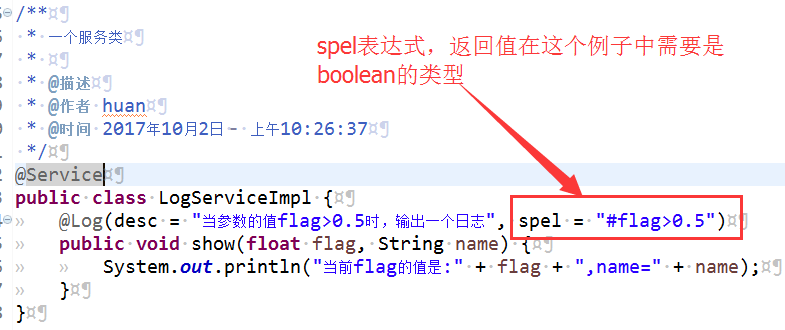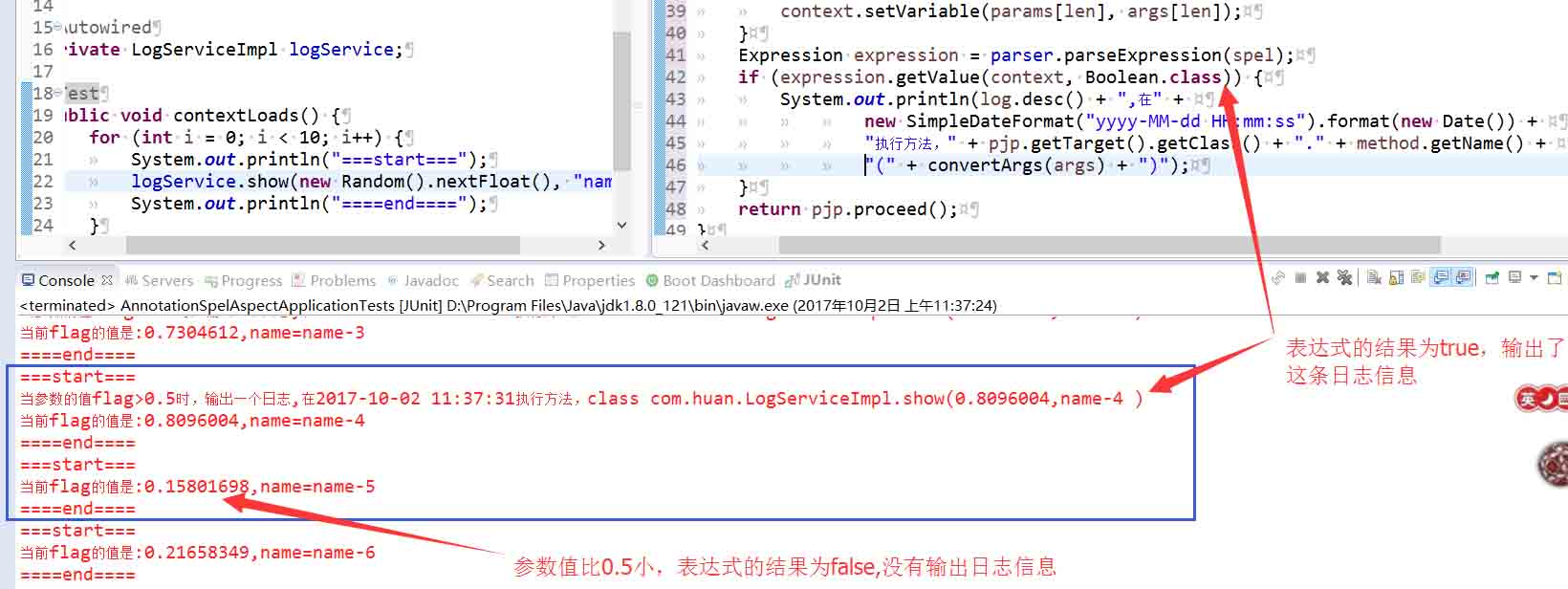这篇文章主要介绍了如何使用Springboot自定义注解并支持SPEL表达式,具有一定借鉴价值,感兴趣的朋友可以参考下,希望大家阅读完这篇文章之后大有收获,下面让小编带着大家一起了解一下。
Springboot自定义注解,支持SPEL表达式
举例,自定义redis模糊删除注解
1.自定义注解
import java.lang.annotation.ElementType;import java.lang.annotation.Retention;import java.lang.annotation.RetentionPolicy;import java.lang.annotation.Target; @Target(ElementType.METHOD)@Retention(RetentionPolicy.RUNTIME)public @interface CacheEvictFuzzy { String[] key() default ""; }2.使用AOP拦截方法,解析注解参数
import org.apache.commons.lang3.StringUtils;import org.aspectj.lang.ProceedingJoinPoint;import org.aspectj.lang.annotation.AfterThrowing;import org.aspectj.lang.annotation.Around;import org.aspectj.lang.annotation.Aspect;import org.aspectj.lang.annotation.Pointcut;import org.aspectj.lang.reflect.MethodSignature;import org.slf4j.Logger;import org.slf4j.LoggerFactory;import org.springframework.beans.factory.annotation.Autowired;import org.springframework.core.LocalVariableTableParameterNameDiscoverer;import org.springframework.core.annotation.Order;import org.springframework.expression.ExpressionParser;import org.springframework.expression.spel.standard.SpelExpressionParser;import org.springframework.expression.spel.support.StandardEvaluationContext;import org.springframework.stereotype.Component; import java.lang.reflect.Method;import java.util.Set;@Aspect@Order(1)@Componentpublic class CacheCleanFuzzyAspect { Logger logger = LoggerFactory.getLogger(this.getClass()); @Autowired private RedisUtil redis; //指定要执行AOP的方法 @Pointcut(value = "@annotation(cacheEvictFuzzy)") public void pointCut(CacheEvictFuzzy cacheEvictFuzzy){} // 设置切面为加有 @RedisCacheable注解的方法 @Around("@annotation(cacheEvictFuzzy)") public Object around(ProceedingJoinPoint proceedingJoinPoint, CacheEvictFuzzy cacheEvictFuzzy){ return doRedis(proceedingJoinPoint, cacheEvictFuzzy); } @AfterThrowing(pointcut = "@annotation(cacheEvictFuzzy)", throwing = "error") public void afterThrowing (Throwable error, CacheEvictFuzzy cacheEvictFuzzy){ logger.error(error.getMessage()); } private Object doRedis (ProceedingJoinPoint proceedingJoinPoint, CacheEvictFuzzy cacheEvictFuzzy){ Object result = null; //得到被切面修饰的方法的参数列表 Object[] args = proceedingJoinPoint.getArgs(); // 得到被代理的方法 Method method = ((MethodSignature) proceedingJoinPoint.getSignature()).getMethod(); String[] keys = cacheEvictFuzzy.key(); Set<String> keySet = null; String realkey = ""; for (int i = 0; i < keys.length; i++) { if (StringUtils.isBlank(keys[i])){ continue; } realkey = parseKey(keys[i], method, args); keySet = redis.keys("*"+realkey+"*"); if (null != keySet && keySet.size()>0){ redis.delKeys(keySet); logger.debug("拦截到方法:" + proceedingJoinPoint.getSignature().getName() + "方法"); logger.debug("删除的数据key为:"+keySet.toString()); } } try { result = proceedingJoinPoint.proceed(); } catch (Throwable throwable) { throwable.printStackTrace(); }finally { return result; } } private String parseKey(String key, Method method, Object [] args){ if(StringUtils.isEmpty(key)) return null; //获取被拦截方法参数名列表(使用Spring支持类库) LocalVariableTableParameterNameDiscoverer u = new LocalVariableTableParameterNameDiscoverer(); String[] paraNameArr = u.getParameterNames(method); //使用SPEL进行key的解析 ExpressionParser parser = new SpelExpressionParser(); //SPEL上下文 StandardEvaluationContext context = new StandardEvaluationContext(); //把方法参数放入SPEL上下文中 for(int i=0;i<paraNameArr.length;i++){ context.setVariable(paraNameArr[i], args[i]); } return parser.parseExpression(key).getValue(context,String.class); }}完事啦!
大家可以注意到关键方法就是parseKey
private String parseKey(String key, Method method, Object [] args){ if(StringUtils.isEmpty(key)) return null; //获取被拦截方法参数名列表(使用Spring支持类库) LocalVariableTableParameterNameDiscoverer u = new LocalVariableTableParameterNameDiscoverer(); String[] paraNameArr = u.getParameterNames(method); //使用SPEL进行key的解析 ExpressionParser parser = new SpelExpressionParser(); //SPEL上下文 StandardEvaluationContext context = new StandardEvaluationContext(); //把方法参数放入SPEL上下文中 for(int i=0;i<paraNameArr.length;i++){ context.setVariable(paraNameArr[i], args[i]); } return parser.parseExpression(key).getValue(context,String.class); }自定义注解结合切面和spel表达式
在我们的实际开发中可能存在这么一种情况,当方法参数中的某些条件成立的时候,需要执行一些逻辑处理,比如输出日志。而这些代码可能都是差不多的,那么这个时候就可以结合自定义注解加上切面加上spel表达式进行处理。就比如在spring中我们可以使用@Cacheable(key="#xx")实现缓存,这个#xx就是一个spel表达式。
需求:我们需要将service层方法中方法的某个参数的值大于0.5的方法,输出方法执行日志。(需要了解一些spel表达式的语法)
实现步骤:
自定义一个注解Log
自定义一个切面,拦截所有方法上存在@Log注解修饰的方法
写一个service层方法,方法上标注@Log注解
难点:
在切面中需要拿到具体执行方法的方法名,可以使用spring提供的LocalVariableTableParameterNameDiscoverer来获取到
自定义一个注解
注意:注解中的spel的值是必须的,且spel表达式返回的结果应该是一个布尔值
@Target({ ElementType.METHOD })@Retention(RetentionPolicy.RUNTIME)public @interface Log {String spel();String desc() default "描述";}自定义一个service类,在需要拦截的方法上加上@Log注解

写一个自定义切面
注意一下解析spel表达式中context的设值即可
@Component@Aspectpublic class LogAspect {ExpressionParser parser = new SpelExpressionParser();LocalVariableTableParameterNameDiscoverer discoverer = new LocalVariableTableParameterNameDiscoverer();@Around("@annotation(log)")public Object invoked(ProceedingJoinPoint pjp, Log log) throws Throwable {Object[] args = pjp.getArgs();Method method = ((MethodSignature) pjp.getSignature()).getMethod();String spel = log.spel();String[] params = discoverer.getParameterNames(method);EvaluationContext context = new StandardEvaluationContext();for (int len = 0; len < params.length; len++) {context.setVariable(params[len], args[len]);}Expression expression = parser.parseExpression(spel);if (expression.getValue(context, Boolean.class)) {System.out.println(log.desc() + ",在" + new SimpleDateFormat("yyyy-MM-dd HH:mm:ss").format(new Date()) + "执行方法," + pjp.getTarget().getClass() + "." + method.getName() + "(" + convertArgs(args) + ")");}return pjp.proceed();}private String convertArgs(Object[] args) {StringBuilder builder = new StringBuilder();for (Object arg : args) {if (null == arg) {builder.append("null");} else {builder.append(arg.toString());}builder.append(',');}builder.setCharAt(builder.length() - 1, ' ');return builder.toString();}}pom文件的依赖
<parent><groupId>org.springframework.boot</groupId><artifactId>spring-boot-starter-parent</artifactId><version>1.5.2.RELEASE</version><relativePath/> <!-- lookup parent from repository --></parent><properties><project.build.sourceEncoding>UTF-8</project.build.sourceEncoding><project.reporting.outputEncoding>UTF-8</project.reporting.outputEncoding><java.version>1.8</java.version></properties><dependencies><dependency><groupId>org.springframework.boot</groupId><artifactId>spring-boot-starter-aop</artifactId></dependency><dependency><groupId>org.springframework.boot</groupId><artifactId>spring-boot-starter-test</artifactId><scope>test</scope></dependency></dependencies><build><plugins><plugin><groupId>org.springframework.boot</groupId><artifactId>spring-boot-maven-plugin</artifactId></plugin></plugins></build>测试

增加内容
当我们想在自己写的spel表达式中调用spring bean 管理的方法时,如何写。spel表达式支持使用 @来引用bean,但是此时需要注入BeanFactory

感谢你能够认真阅读完这篇文章,希望小编分享的“如何使用Springboot自定义注解并支持SPEL表达式”这篇文章对大家有帮助,同时也希望大家多多支持编程网,关注编程网行业资讯频道,更多相关知识等着你来学习!






